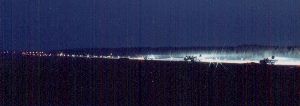The operations of the Russian air forces differed a lot from the NATO operations we were used to. Some observations are listed here.
The Russians air force, as all WarPac air forces, used 'flying days'. It means that each unit was assigned (usually) two days a week for flying. The rest of the week is used for maintenance and preparation of missions. But it must be said that when it was a flying day, they would make quite a lot of missions.
Being used to NATO air forces that fly five days a week, and unaware of the flying days, spotters often sat frustrated at airfields waiting for flying activities. But we learned quickly. The rumor was that the initial list of flying days was given to some spotters by Dutch intelligence.
XXXX Table of flying daysXXXXA possible explanation for the use of flying days was that East Germany was so stuffed with aircraft and helicopters, that it would be impossible to have all units flying every day. But the concept of flying days is also used in other, less-crowded WarPac countries.
Flying operations were performed from a flightline. At the start of a flying day, the aircraft were towed from the shelters to the flightline. There were no specialised tow tractors for this purpose; the towing was done with all kinds of trucks. Each aircraft had its own towing bar, on which the boarding ladder and a tool box could be attached. The aircraft code was painted on things like engine covers, so nothing could be mixed up. The end result, a flightline full of aircraft, surely was an impressive sight.
Before the operational flying started, a weather flight was sent out. Usually a two-seater was used for this. On days with nice weather this is a bit of a joke, and we sometimes saw the pilot just play around and make high speed fly-bys. I asked people who worked in RNLAF in the fifties, and they told me they used to have a weather flight too. But this practise is long been abolished in the west.
As far as we could judge from the outside, the training missions were highly regulated. We would usually see each and every aircraft fly the same pattern. Some examples:
Another nice example was observed at Brand, a MiG 27 base. Four Floggers took off, and one spotter decided to follow them as long as he could using his 20 times binoculars. The weather was very nice, and he could follow them for a long time, flying west towards Jüterbog. Just at the point he feared losing them, they made a turn north and started diving. They disappeared behind the horizon, but a little later they appeared again. Clearly they were using a bombing range, each making a single dive attack. After that they returned to Brand. The whole mission was thus observed visually! From Lutz Freundt's third book we now know the bombing range involved was called 'Heidehof', a large area of roughly 22 by 6 kilometers between Jüterbog, Luckenwalde and Baruth. The distance from Brand air base to the center of the bombing range is just a mere 30 kilometers!
The traffic patterns used by the Russians were also different. In good or fair weather, NATO pilots use a rather thight circuit (initial, downwind, base turn, base leg), or a ground-controlled straight-in during bad weather. I've seen the Russians only fly one type of pattern, which was quite wide. The following sketch is based on information provided by a German enthusiast.
XXXXX Patroon XXXXXAt Finow a Russian alternative for a wind sock was seen. Four oildrums filled with scrap wood / oil / rubber were placed along the runway, and lit. Their smoke clearly showed the wind direction to the pilots. It is not clear whether this was a standard procedure, but it surely is a simple solution, although not so environment-friendly.
I have very fond memories of the few times I saw the Russians train night flying. Trucks with giant searchlights were positioned near the runway threshold, and the flooded the runway with light. Every time an aircraft took off or made a landing, these lights were switched on. The sight of a landing aircraft suddenly illuminated over the runway was incredible.

| |
| Welzow during night flying operations. Photo by Lindsay Peacock. | |
Another noticable difference with NATO operations is that we have never observed aircraft from one air base visiting another. Possibly the bases had no cross-servicing facilities. One exception was a visit in 1990 of six East German MiG 21's to Welzow, where Su 24's were operated. On NATO airbases it's quite common to see visiting aircraft. Reasons are to get air forces acquinted with and learn from each others operations, to train ground personel in handling different aircraft (cross-servicing), and to provide dissimilar air combat training. Possibly the Russians didn't value this much.

|

|
| At the almost deserted Allstedt air base we found this sign showing the rocket armament of the Su 17M based there. It shows very detailed information of the various rockets used. Photo by Rob de Bie | |
Despite the limited number of flying hours allocated to the Russian pilots, the flying safety record was pretty good. Between 1990 and 1994 six aircraft crashed:
Note that the famous MiG 23 crash in Belgium was Poland-based MiG 23 unit